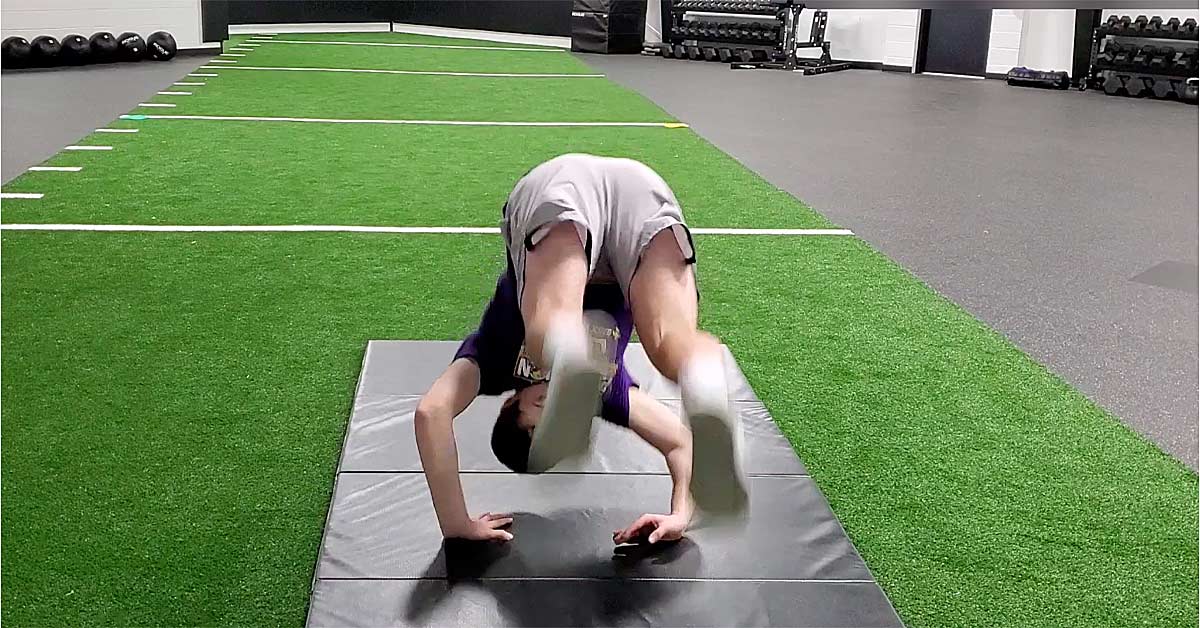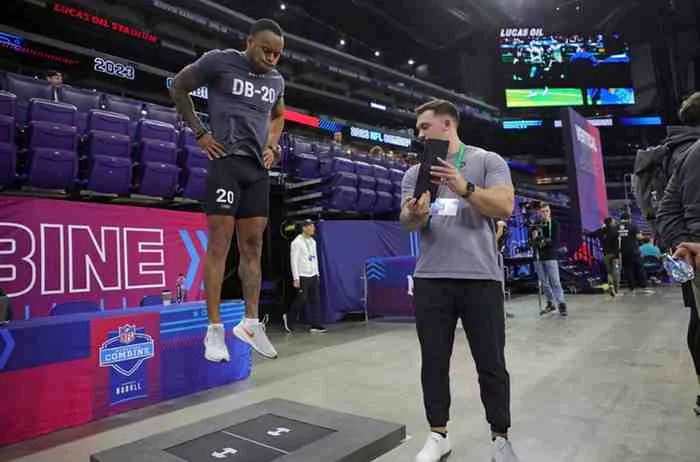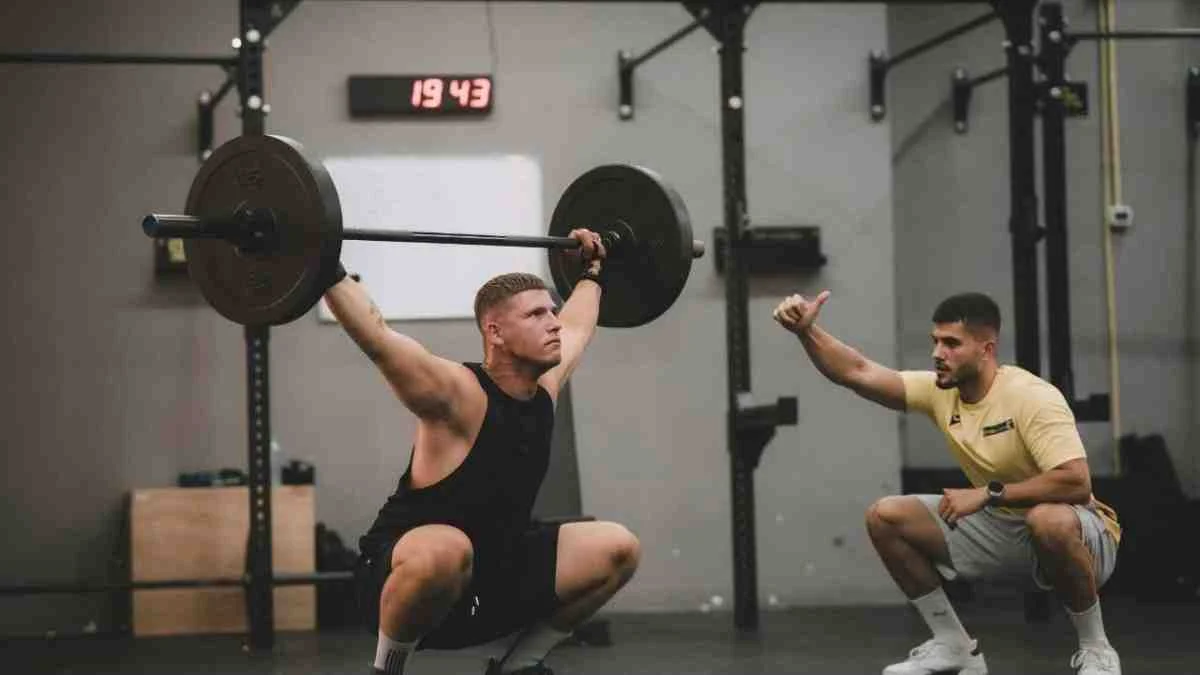[mashshare]
One of the first lessons that Marines learn in Basic Training is the art of falling. It wasn’t until I got into strength and conditioning that I realized how versatile and vital that lesson proved to be. I have fallen with a fully loaded rifle when rolling to cover from enemy fire. I have fallen in a soccer game with a “friendly” assist from an opponent. I’ve slipped on a patch of ice outside of a local watering hole during the dead of winter. Knowing how to fall saved me from a potentially catastrophic injury in each circumstance.
The ability to fall correctly, however, goes beyond injury prevention. Teaching athletes the proper ways to fall can simultaneously train their vestibular systems, their coordination, and their proprioception. Consider a parkour athlete’s ability to jump and roll out of extreme heights without injury. This isn’t some genetic gift—it’s a set of skills that allows them to walk away unscathed.
Teaching athletes the proper skills to fall will set them up for success for a lifetime—the athlete’s parents will instantly realize their child’s health is your top concern. This article will be a short, concise way on how to implement various falls into your training.
The Falling Epidemic
Falls cause 37.3 million injuries each year1, and if that doesn’t alarm you, falls are also the second greatest cause of unintentional deaths globally—exceeded only by motor vehicle collisions2. One fall-related injury is so common that it has earned an acronym, FOOSH (Fall on an Outstretched Hand): “A FOOSH type of injury is the second most common type of sports injury.”
Preventing injuries is a top priority for parents and coaches alike, and rightly so. The quest for injury prevention, however, is often launched without first scouting for low-hanging fruits. Given the frequency and magnitude of injuries from falls, learning to fall properly can be a first step in injury prevention that will pay dividends long after the athlete retires from competitive sports. Furthermore, mastering falling skills will improve athletic performance and translate quickly to the court or the field.
Mastering falling skills will improve athletic performance and translate quickly to the court or the field. Share on XMany of my athletes come to me barely able to stand after a somersault. Within a few short weeks of training, however, they are capable of popping up off the ground and continuing a play. As we age, the ability to fall in an athletic fashion becomes harder and harder. Practicing falling skills will not only help with coordination but also with longevity. In the elderly population, even those falls that are due to low-energy mechanisms are associated with higher hospitalization rates, longer lengths of hospital stays, and higher rates of mortality.3 Ten to fifteen percent of emergency room visits are attributed to falls.4 Injury prevention strategies should start with learning how to properly fall.
How to Teach Falling the Right Way
With new athletes, I incorporate falls into my first few sessions and then review them periodically. I aim to give the athlete the proper tools to utilize in various off-balance situations rather than preaching one specific way to fall.
Once my athletes are comfortable with rolling, they typically do that more than any break fall. I implement rolls as reactionary drills by having athletes roll, recover, and react to a stimulus (colored agility dot, ball, number, etc.). The athlete learns to stay in the play rather than lying there helplessly. These drills mimic in-game scenarios and randomize training. The drill is effective and enjoyable for the athlete as well.
Key Concepts to Building Falling Skills:
- DO NOT have athletes plant hand or elbow during any point of the fall.
- ALWAYS have athletes keep their chin tucked away from ground when falling.
- Have athletes start these movements as close as possible to the floor and progress by adding height/speed.
- Lying > Seated > Squatting > Kneeling > Standing > Walking > Jogging > Running
Front-Break Fall from a Kneeling Position
Video 1. Front-Break Fall. Key situations: pushed from behind trying to head the ball in soccer; pushed in football; diving back to a base in baseball to avoid pickoff.
- Athlete kneels down with a mat in front of them. Cue the athlete to raise their chin to the sky.
- Athlete bends their elbows close to their body and has palms facing the direction they will fall. This allows the athlete to displace the force from the fall.
- Have athletes begin to fall forward and then break their fall with their forearms and palms, which should strike the ground simultaneously. Fingers should be extended.
- Ensure that the athlete keeps their chin high to avoid striking the floor with their head.
Side-Break Fall from a Kneeling Position:
Video 2. Side Break Fall. Key situations: FOOSH most commonly occurs in this fall; Football player being pushed out of bounds; attempting to remain upright.
- Athlete assumes a single-leg kneeling position.
- They look to the opposite shoulder of the falling direction.
- They begin to fall to the deck and break their fall with their arm slapping the floor, with their forearm and hand hitting simultaneously.
- Their break arm should land under the head, or at a 45° angle toward their feet.
- Have athlete stretch out the falling side leg and allow the other leg to bend, allowing their foot to contact the ground.
Rear-Break Fall from Squatted Position:
Video 3. Rear-Break Fall. Key situations: quarterback being pushed to the ground; basketball player taking a hard foul.
- Athlete gets down to a low squat position and tucks their chin into their chest.
- They roll backward to begin the fall.
- Keeping the chin tucked to their chest, have them slap the floor with both arms extended and palms facing down to disperse the force. Arms should hit at a 45° angle from the body.
- Keeping head tucked forward will protect head and neck areas from injury.
Front Roll from Squatted Position
Video 4. Front Roll. Key situations: any fall with forward momentum; being tripped during running on a play.
- Athlete gets down to a low squat position and tucks their chin into their chest.
- They distribute weight onto the balls of their feet and ensure hips are higher than shoulders (think frog stance or position).
- Have athlete begin roll and ensure their head does not contact the floor during the roll.
- Have athlete maintain a flexed spine in order to transition out of the roll.
- This movement is very similar to the side roll and many times can be adjusted on the fly if the athlete is capable.
Backward Roll from Squatted Position
Video 5. Backward Roll. Key situations: Any fall with backward momentum; being pushed over on a kickoff when the play is continuing on.
- Have athlete get down to a low squat position and tuck their chin into their chest.
- Athlete places hands on shoulders with palms facing up.
- They begin by rolling back, being sure to keep a tucked chin.
- Athlete plants their hands and pushes themselves up to complete the roll.
- They land on feet and extend arms to stand up.
Reactive Falling Drills
Video 6. Reactive Falling Drills. Key situations: makes athletes use their fall skills in sport environments to gain a comfort level, reactivity, and awareness to the play.
- Use an external stimulus to create an environment where the athlete must roll, recover, and react.
- Start by having an athlete perform a roll.
- Use colored agility dots, cones, balls, people, numbers, etc. and have athletes react to this cue after completing the roll.
- This helps with in-game transitions and keeps the athlete in the play.
A Valuable Lesson
Never assume an athlete has the ability to carry out a well-executed fall. I learned this when I first began teaching one of my athletes how to fall—I asked a high school football player (QB1) if he could perform a simple somersault. With a raised eyebrow, he replied with a cocky, “Are you serious? Of course, I can.”
Never assume an athlete has the ability to carry out a well-executed fall. Share on XWhat ensued next was a horrific display of exactly what you don’t want to do. This athlete began his somersault by placing the full weight of his body on the neck/head area. When he rolled over, the neck and spine were placed in an extremely compromising position. I was immediately overcome with anxiety at the potential spinal injury I had just allowed to happen and wondered if I needed to grab my C-collar and spine board (just kidding). Luckily, that particular athlete ultimately finished the somersault unscathed.
That circumstance, however, taught me a valuable lesson to not assume the abilities of any athlete, especially pertaining to falling. Previously, this athlete had broken his wrist from a FOOSH mechanism, so he was eager to continue to learn how to fall properly. Now he is confident in his ability to fall and to properly protect himself from future injury. He has grown to love the falling drills we practice on a weekly basis, and it became a significant buy-in factor for both him and his parents.
Today, when I explain to parents that their son/daughter can expect to learn how to fall, they instantly love the idea and question why others haven’t taught this skill. It immediately shows that we (the coaches) care about an athlete’s well-being and injuries caused by falling. As coaches, we have the ability to change the falling narrative by introducing these falls into every athlete’s repertoire.
References
1. “Falls.” World Health Organization, World Health Organization, www.who.int/news-room/fact-sheets/detail/falls.
2. Granhed H, Altgarde E, Akyurek LM, David P (2017) Injuries Sustained by Falls – A Review. Trauma Acute Care 2:38. doi: 10.21767/2476-2105.100038
3. Lee, Hyeji et al. “Severe Injuries from Low-height Falls in the Elderly Population.” Journal of Korean medical sciencevol. 33,36 e221. 5 Jul. 2018, doi:10.3346/jkms.2018.33.e221
4. Spaniolas, Konstantinos, et al. “Ground Level Falls Are Associated with Significant Mortality in Elderly Patients.” The Journal of Trauma: Injury, Infection, and Critical Care, vol. 69, no. 4, 2010, pp. 821–825., doi:10.1097/ta.0b013e3181efc6c6.
Since you’re here…
…we have a small favor to ask. More people are reading SimpliFaster than ever, and each week we bring you compelling content from coaches, sport scientists, and physiotherapists who are devoted to building better athletes. Please take a moment to share the articles on social media, engage the authors with questions and comments below, and link to articles when appropriate if you have a blog or participate on forums of related topics. — SF
[mashshare]





